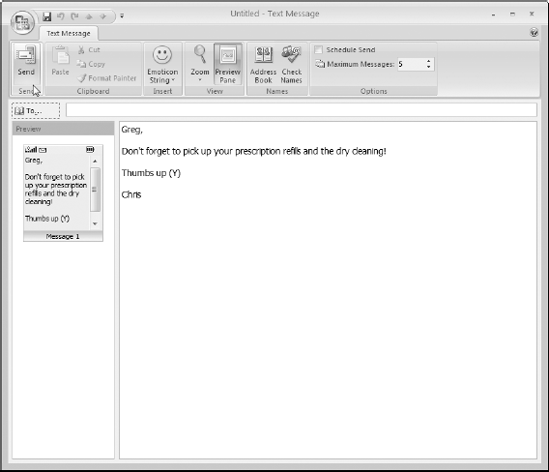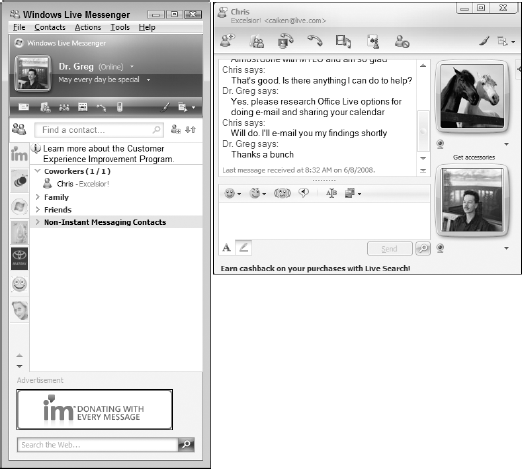A large part of maintaining the peak personal productivity you've achieved is being able to be productive even when you're on the go. More and more, it's not enough simply to have access to your Outlook e-mail messages, calendars, and task list when you're in your office. You also need to be able to deal with these items when you're on the move, whether it's close to home on your daily commute to and from the office or far away on business trips to other cities and countries.
With the large-scale introduction of wireless technology in the form of Wi-Fi and Bluetooth, it's now possible to take your Outlook data with you wherever you go, not only on your laptop computer, but also on your Smartphone (a mobile phone equipped with at least Internet and text messaging capabilities, such as the BlackBerry Curve or Palm Treo) or PDA (personal digital assistant such as an HP iPAQ or Palm T/X).
In response to this new reality on the ground — and on the seas and in the air — this chapter covers accessing your Outlook data from your mobile devices and keeping it synchronized, as well as ways you can access your e-mail messages and calendar on the Internet during those times when you can't access these items using the traditional Outlook program.
The good news is that once you get your mobile device (be it a Smartphone or a PDA) configured to accept Outlook data items, synchronizing those items between your mobile device and laptop or desktop computer is no harder than establishing a connection between them. To configure your mobile device for Outlook, you first need to install the utility programs for managing data supplied with the mobile device on the computer that runs Outlook. These programs generally enable you to load various applications on your mobile device as well as back up its data and, most importantly, synchronize data between your computer and the mobile device.
After installing this data management software, you next need to connect the mobile device to the laptop or desktop computer. Connections between a mobile device like a Smartphone or PDA and a computer are normally accomplished via a USB connector between the two devices or, alternatively, wirelessly via Bluetooth technology (although some mobile devices can also connect to a computer via a serial cable connection).
Then, to get Outlook data such as the contacts in your address book, appointments and events on your calendar, and to-do items on your task list onto your mobile device and keep these items updated, you need to find and launch the utility program installed on your computer that synchs your mobile device.
For my BlackBerry Pearl Smartphone, this particular utility is called Synchronize and is part of the BlackBerry Desktop Manager that I use to control all aspects of synchronization with the cell phone. Figure 15-1 shows you the options that appear on the Synchronize tab of this utility's Synchronize dialog box; these options enable me to specify automatic synchronization whenever the Smartphone is connected to my computer. Figure 15-2 shows you the Configuration dialog box that enables me to specify which Outlook data items to keep synchronized on my cell phone.
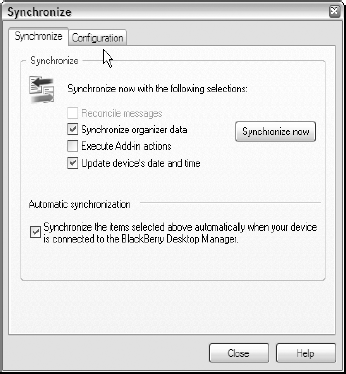
Figure 15-1. Selecting how and when desktop Outlook data is synchronized on my BlackBerry Pearl Smart-phone.
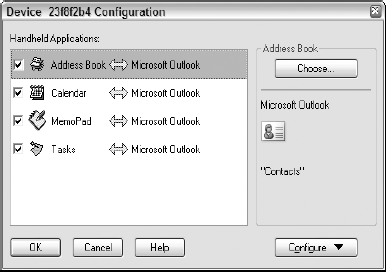
Figure 15-2. Specifying which Outlook items are to be synchronized on my BlackBerry Pearl Smart-phone.
As you can see in Figure 15-2, not only can I use the configuration options in this dialog box to specify that I want to keep the Outlook address book, calendar, notes, and tasks current on my BlackBerry, but in so doing, I also specify which Outlook folders to use. This means, for example, that I can keep a calendar different from my default Outlook calendar synched on my BlackBerry should I feel the need to. (See Chapter 10 for information on keeping more than one calendar in Outlook.)
Note
Keep in mind that synchronization between your computer and mobile device is a two-way street. So, for example, if I change the Status from Busy to Tentative on an appointment on my BlackBerry calendar or the Status from In Progress to Completed on a to-do item on my BlackBerry task list, then the very next time I synchronize the data, the Synchronize software will modify the appointment in my Outlook calendar and the to-do item on my Outlook task list to reflect these changes.
If you have a teenager at home, then I certainly don't have to tell you that text messaging is all the rage with the younger generation. Of course, you don't have to be sixteen years old to appreciate the ability to send messages to a cell phone, especially if that phone isn't equipped to send and receive regular e-mail. Being able to send text messages from Outlook on your computer in the office to cell phones "somewhere out there" can save you a tremendous amount of time in keeping in touch with co-workers and clients who are either traveling or working in the field.
Outlook 2007 makes it simple to send a text message to any cell phone that supports text messaging. All you need to do is install Outlook Mobile Services (OMS for short) on the computer running Outlook 2007. And to accomplish this installation, you need to select an SMS (Short Messaging Service) provider who covers the cellular network (T-Mobile, Verizon Wireless, AT&T Wireless, and so on). To find such an SMS provider, set up an account with them and download the OMS software, visit http://messaging.office.microsoft.com on the Internet.
Note
After you set up an account and install the SMS software, you can then send a text message to any cell phone directly from Outlook 2007 by choosing File
Outlook 2007 then opens a new Untitled – Text Message window, similar to the one shown in Figure 15-3. As you can see in this figure, this window is divided into two sections: a Preview pane on the left and the pane where you type in the text of your message on the right.
To compose a new message in this window, enter the recipient's cell phone number in the To text box or select it from your address book by clicking the To button and then clicking the name and cell phone number in Select Names: Contacts (Mobile) dialog box before you click OK.
Then, click the cursor in the pane on the right and type in the text of your message. (You can see how its lines wrap in the Preview pane on the left.) After you finish typing the message text, you're ready to send your text message by clicking the Send button.
Note
Keep in mind that, if you're still using Outlook 2003 and you want to be able to send text messages from this version of Outlook, you can do so by finding an SMS provider who covers your cellular network and then downloading and installing a separate SMS (Short Messaging Service) plug-for Outlook. One such provider who offers an Outlook plug-in and support for a wide array of different cellular networks (both here in the United States and abroad) is SMSCountry at www.smscountry.com.
Instant messaging (IM, for short) makes it possible for you and another co-worker or client to exchange text messages, video, and audio over the Internet in real time (unlike the back-and-forth of e-mailing and, too often, that of telephone tag). Instant messaging facilitates impromptu communication of all sorts, all the way from quick question-and-answer sessions to keeping in touch with colleagues, friends, and family and catching up on the latest chitchat.
Lots of different IM software programs are available for Internet real-time communication. One of the most popular IM programs (and possibly the most compatible with Outlook) is Microsoft's Windows Live Messenger (see Figure 15-4). This IM software enables you to exchange real-time text messages as well as video (assuming that both contacts have webcams on their computers).
When using use an instant messenger program such as Windows Live Messenger, you can tell whether or not people in your Outlook address book are online and available for messaging by adding their IM addresses in their contact records and by turning on the Display Messenger Status in Outlook feature. To do this, follow these steps:
Launch Outlook as you normally do and then choose Tools

Outlook opens the Preferences tab of the Options dialog box.
Click the Other tab in the Options dialog box and then in Outlook 2003, select the Enable the Person Names Smart Tag check box in the Person Names section at the bottom of this tab. In Outlook 2007, you select the Display Online Status Next to a Person Name check box, instead.
As soon as you select the Enable the Person Names Smart Tag check box in Outlook 2003 or the Display Online Status Next to a Person Name check box in Outlook 2007, the Display Messenger Status in the From Field check box becomes active.
Select the Display Messenger Status in the From Field check box and then click OK.
After turning on the Display Messenger Status in Outlook, you still have to add the IM address for each contact with whom you do instant messaging.
In the Find button's text box on the Standard toolbar (or on your custom Productivity toolbar if you created one), type the name of the contact whose IM address you want to add and then press Enter.
Outlook opens the Contact dialog box for the contact name you entered.
Click the IM Address field and type in the contact's instant message address and then click the Save and Close button.
After adding the IM address for each contact with whom you want to be able to conduct instant messaging, Outlook then displays the current status of any contact when he or she sends you a regular e-mail message. All you have to do is open the e-mail message in the Mail module and then position the mouse pointer over the person's name in the From field at the top message (see Figure 15-5). Outlook then displays a colored circle indicating the person's current online status (green for online and available, red for offline, and tan for online and busy).
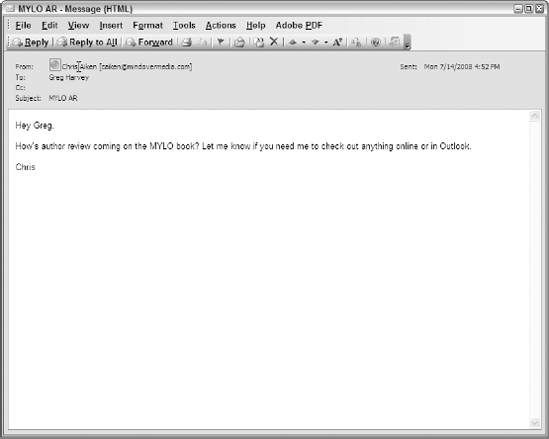
Figure 15-5. Position the mouse pointer on the sender's name in an open e-mail message to see if that contact's currently available for instant messaging.
Tip
If the person's status indicates that he or she is now online and available for messaging, you can then reply by sending an instant message instead of sending a standard e-mail reply. All you have to do is position the mouse pointer on the green indicator ball next to the person's name in the From field until a drop-down button appears. Then, click the drop-down button and choose Reply with Instant Message from the menu that appears.

